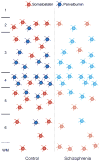Prenatal ontogeny as a susceptibility period for cortical GABA neuron disturbances in schizophrenia
- PMID: 23769891
- PMCID: PMC3816121
- DOI: 10.1016/j.neuroscience.2013.06.008
Prenatal ontogeny as a susceptibility period for cortical GABA neuron disturbances in schizophrenia
Abstract
Cognitive deficits in schizophrenia have been linked to disturbances in GABA neurons in the prefrontal cortex (PFC). Furthermore, cognitive deficits in schizophrenia appear well before the onset of psychosis and have been reported to be present during early childhood and even during the first year of life. Taken together, these data raise the following question: Does the disease process that produces abnormalities in prefrontal GABA neurons in schizophrenia begin prenatally and disrupt the ontogeny of cortical GABA neurons? Here, we address this question through a consideration of evidence that genetic and/or environmental insults that occur during gestation initiate a pathogenetic process that alters cortical GABA neuron ontogeny and produces the pattern of GABA neuron abnormalities, and consequently cognitive difficulties, seen in schizophrenia. First, we review available evidence from postmortem human brain tissue studies characterizing alterations in certain subpopulations of prefrontal GABA neuron that provide clues to a prenatal origin in schizophrenia. Second, we review recent discoveries of transcription factors, cytokine receptors, and other developmental regulators that govern the birth, migration, specification, maturation, and survival of different subpopulations of prefrontal GABA neurons. Third, we discuss recent studies demonstrating altered expression of these ontogenetic factors in the PFC in schizophrenia. Fourth, we discuss the potential role of disturbances in the maternal-fetal environment such as maternal immune activation in the development of GABA neuron dysfunction. Finally, we propose critical questions that need to be answered in future research to further investigate the role of altered GABA neuron ontogeny in the pathogenesis of schizophrenia.
Keywords: development; interneuron; parvalbumin; prefrontal cortex; somatostatin.
Copyright © 2013 IBRO. Published by Elsevier Ltd. All rights reserved.
Figures


References
-
- Akbarian S, Bunney WE, Jr, Potkin SG, Wigal SB, Hagman JO, Sandman CA, Jones EG. Altered distribution of nicotinamide-adenine dinucleotide phosphate-diaphorase cells in frontal lobe of schizophrenics implies disturbances of cortical development. Arch Gen Psychiatry. 1993;50:169–177. - PubMed
-
- Akbarian S, Kim JJ, Potkin SG, Hagman JO, Tafazzoli A, Bunney WE, Jr, Jones EG. Gene expression for glutamic acid decarboxylase is reduced without loss of neurons in prefrontal cortex of schizophrenics. Arch Gen Psychiatry. 1995;52:258–266. - PubMed
-
- Anderson S, Volk DW, Lewis DA. Increased density of microtubule-associated protein 2-immunoreactive neurons in the prefrontal white matter of schizophrenic subjects. Schizophr Res. 1996;19:111–119. - PubMed
-
- Anderson SA, Eisenstat DD, Shi L, Rubenstein JLR. Interneuron migration from basal forebrain to neocortex: Dependence on Dlx genes. Science. 1997;278:474–476. - PubMed
Publication types
MeSH terms
Grants and funding
LinkOut - more resources
Full Text Sources
Other Literature Sources
Medical
Miscellaneous

